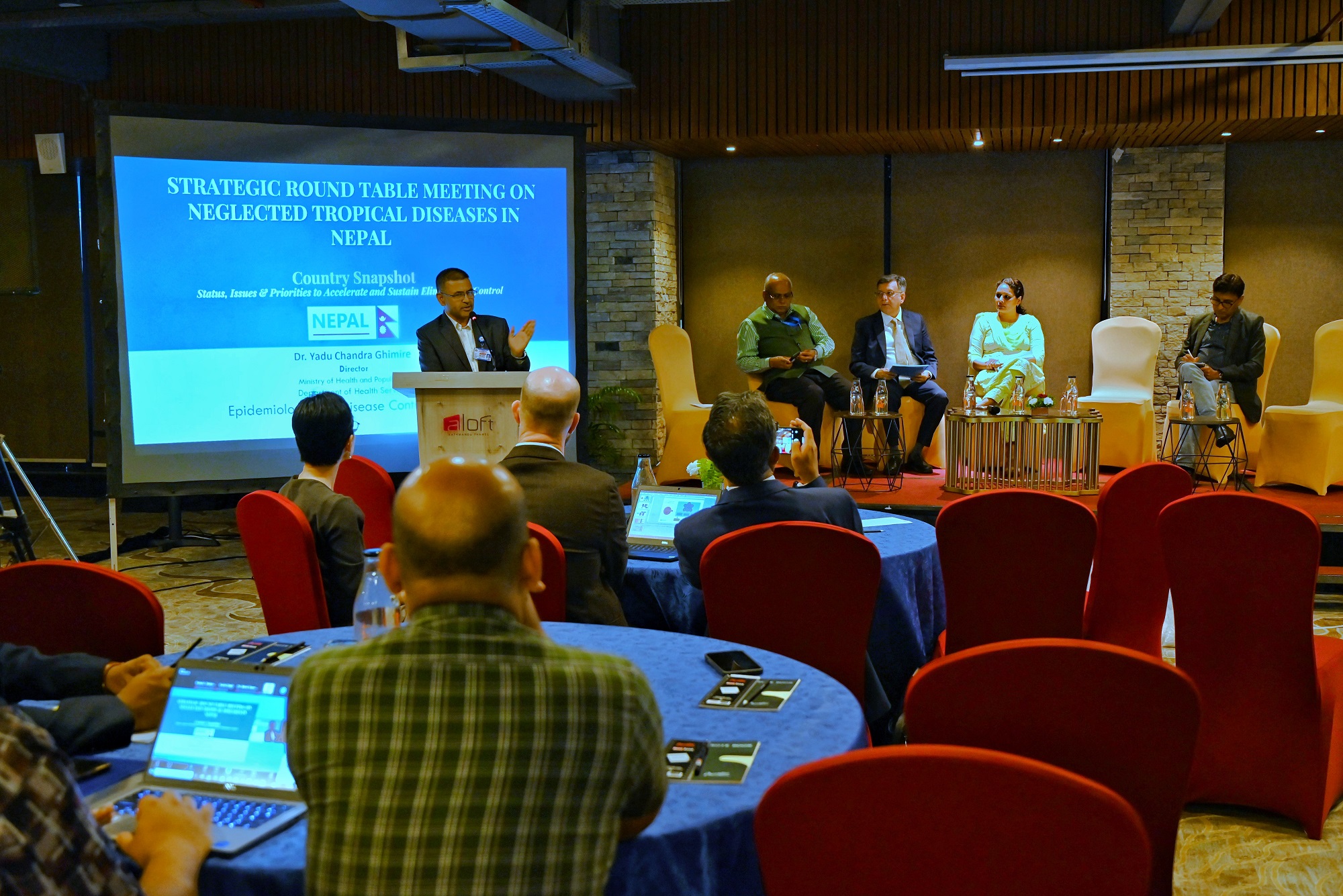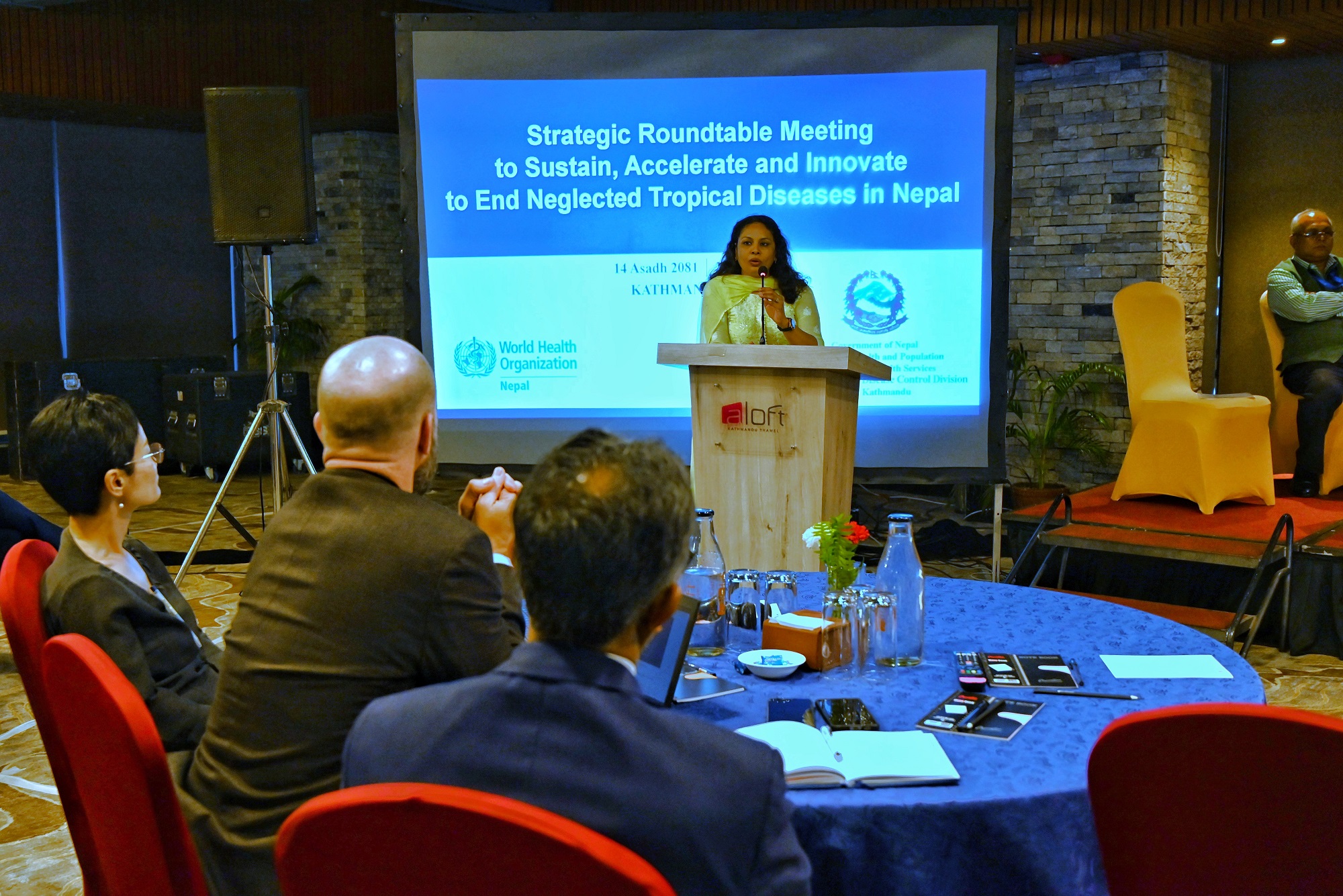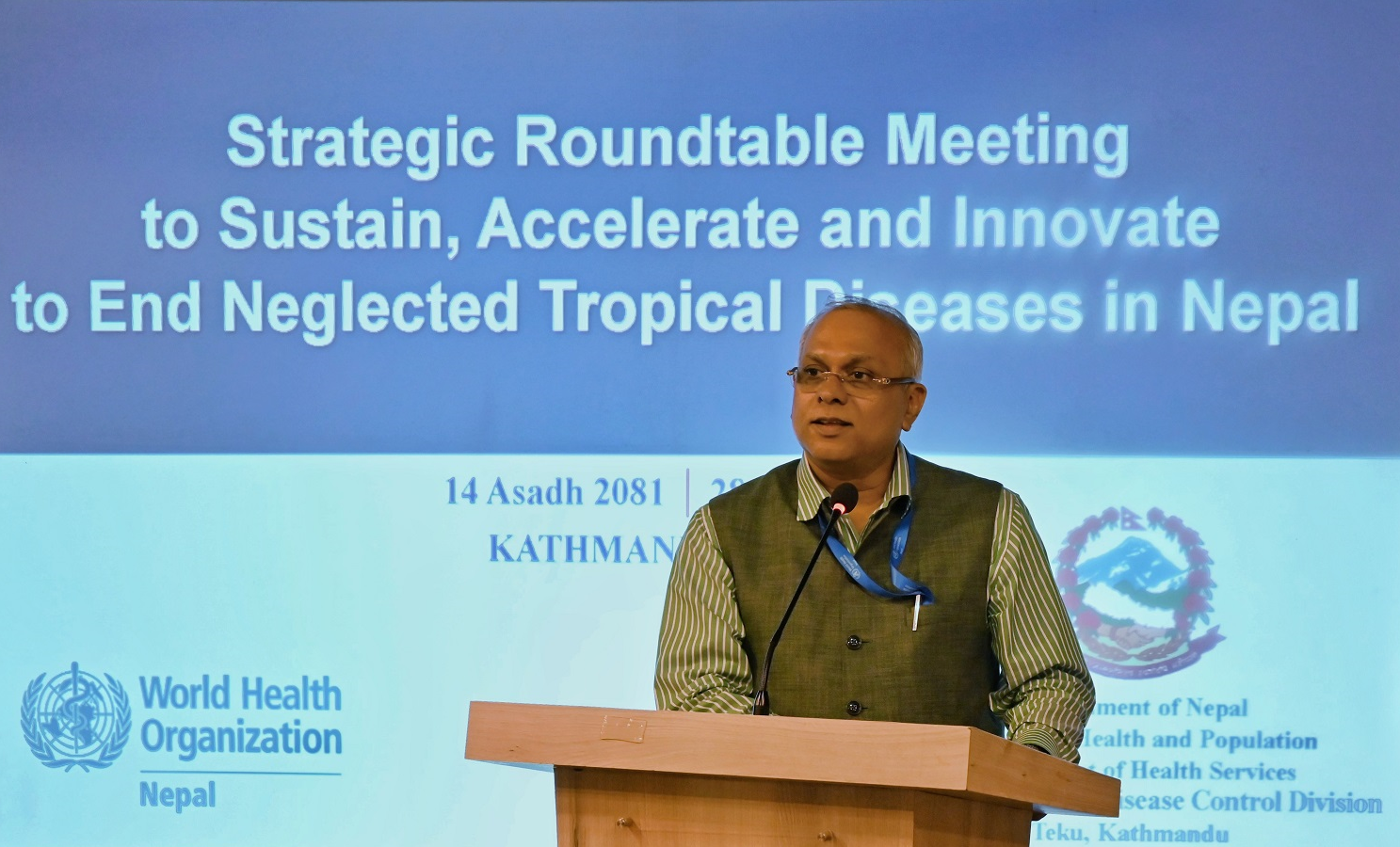In a significant step towards eliminating Neglected Tropical Diseases (NTDs) in Nepal, the Ministry of Health and Population (MoHP) and WHO Country Office for Nepal hosted a strategic roundtable meeting in Kathmandu.
The meeting aimed to accelerate efforts to end NTDs that disproportionately affect marginalized populations in Nepal, such as lymphatic filariasis, kala-azar, leprosy, dengue, rabies and snakebite envenoming, among others.

Dr Yadu Chandra Ghimire, Director of the Epidemiology and Disease Control Division, Ministry of Health and Population, highlighting the status and issues on neglected tropical diseases (NTDs) in Nepal at the high-level strategic roundtable meeting. Photo credit: WHO Nepal
WHO has identified 21 NTDs globally, with 11 of them present in Nepal. So far, Nepal's notable successes include the elimination of leprosy as a public health problem at the national level in 2010, elimination of trachoma as a public health concern in 2018, a decrease in new reported cases of kala-azar by 90 per cent, and expansion of access to snakebite treatment in 110 centres nationwide. However, other NTDS still pose significant public health challenges.
To effectively combat these diseases in Nepal, WHO recommends a coordinated effort involving multiple sectors like animal health, water, sanitation, hygiene (WASH), education and the private sector. In line with the WHO Roadmap for Neglected Tropical Diseases 2021-2030, continuous advocacy, strengthened national ownership and strong political commitment at all levels are also crucial.
In this light, the high-level strategic roundtable meeting, held on 28 June, brought together officials from various sectors, including MoHP, the Ministry of Agriculture and Livestock Development (MOALD), and senior officials from the Epidemiology and Disease Control Division (EDCD).
Representatives from WHO, and partners such as USAID, the Bill and Melinda Gates Foundation, Drugs for Neglected Tropical Diseases Initiative (DNDi) and PATH International also participated. Representatives from RTI International, FAIRMED Foundation, Public Health and Infectious Disease Research Center (PHIDReC) and FAO were also in attendance.
Chaired by Dr Sangeeta Kaushal Mishra, Director General of the Department of Health Services (DOHS), MoHP, the event featured presentations and a panel discussion - all focusing on sustaining accelerating and innovating efforts to eliminate NTDs in Nepal.

Participants from the high-level strategic roundtable meeting held in Nepal. Photo credit: WHO Nepal
The discussions were enriched by virtual and in-person participation from provincial health directorates and participating agencies. Key presentations and discussions highlighted the current status and burden of NTDs in Nepal, as well as ongoing efforts to combat them. Participants reviewed global and regional updates on the eradication, elimination and control of NTDs, and explored ways to contextualize these into Nepal's National NTD Roadmap.
The event fostered partnerships and invigorated commitment to align strategic direction and priorities among government agencies, nongovernmental organizations, international partners, donors and other stakeholders.
Major issues discussed included gaps in disease data that require national-level surveys and research, challenges in scaling up interventions for lymphatic filariasis and leprosy, limitations of the existing surveillance system and funding shortfalls in critical areas like rabies and snakebite management. The need for sustained post-validation surveillance activities for trachoma and addressing human resource gaps in key areas such as entomology were also emphasized.
Dr Yadu Chandra Ghimire, Director of the EDCD, provided an overview of Nepal's progress and the challenges in eliminating and controlling NTDs. Dr Ghimire welcomed continued support from international partners, reaffirming Nepal's commitment despite constraints in human resources, finance and technical expertise.
Dr Jonathan King from WHO headquarters and Dr Aya Yajima from WHO South-East Asia Regional Office (SEARO) highlighted Nepal's progress and its impact on global NTD elimination efforts.
Dr Suman Rijal, Director of the Communicable Diseases and Surveillance Unit at WHO SEARO, praised Nepal's efforts and emphasized the shared responsibility among all stakeholders. He highlighted the importance of reaching vulnerable populations, especially women and children, and improving access to technology and innovations.
A panel discussion with representatives from EDCD, USAID, BMGF, PATH and DNDi, explored opportunities to align Nepal's priorities with the strategic efforts of these agencies.
The roundtable generated commitments in several areas, including integrated approaches to skin diseases like leprosy and cutaneous leishmaniasis, enhanced surveillance systems, operational research to address evidence gaps, and capacity building for vector surveillance and control. These commitments aim to align resources with national priorities and enhance ongoing progress.

Dr Sangeeta Kaushal Mishra, Director General of Department of Health Services, Ministry of Health and Population, providing her remarks at the event. Photo credit: WHO Nepal
“Despite the significant progress made in combating NTDs in Nepal and overcoming various challenges, we now require additional resources and stronger partnerships. This is the right time to break down silos and engage in multi-sectoral collaboration, pooling financial resources, expertise and cooperation to achieve our goal," said Dr Sangeeta Kaushal Mishra, Director General, DoHS, MoHP.

Dr Rajesh Sambhajirao Pandav, WHO Representative to Nepal, providing his remarks at the event. Photo credit: WHO Nepal
"Nepal has made significant progress in combating NTDs through decades of control and prevention efforts. The final phase of disease elimination demands focused strategies, intensified efforts and innovative approaches. This meeting has set the stage for more rapid and coordinated actions, and I am confident that the collaborative efforts and commitments from various stakeholders will greatly enhance Nepal's ability to address and eventually eliminate these diseases,” said Dr Rajesh Sambhajirao Pandav, WHO Representative to Nepal.
WHO will continue to support the Government of Nepal by providing essential technical assistance and advocating for multisectoral coordination and resource alignment, to sustain, accelerate and innovate in the fight against NTDs in Nepal.
